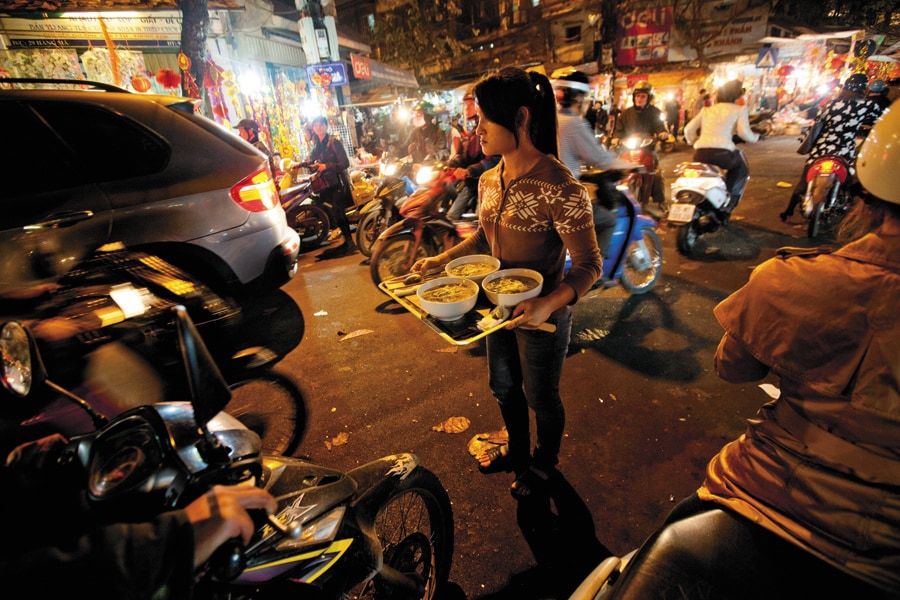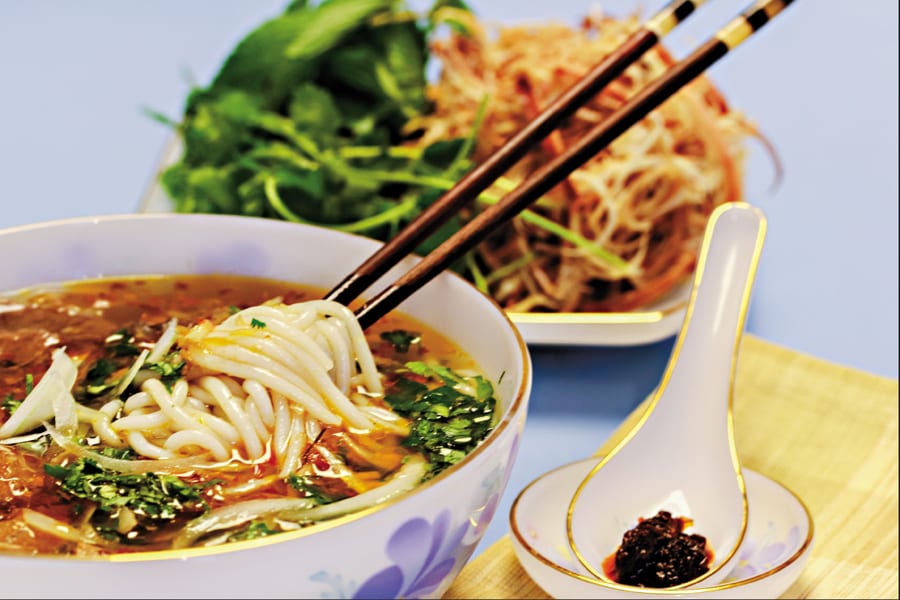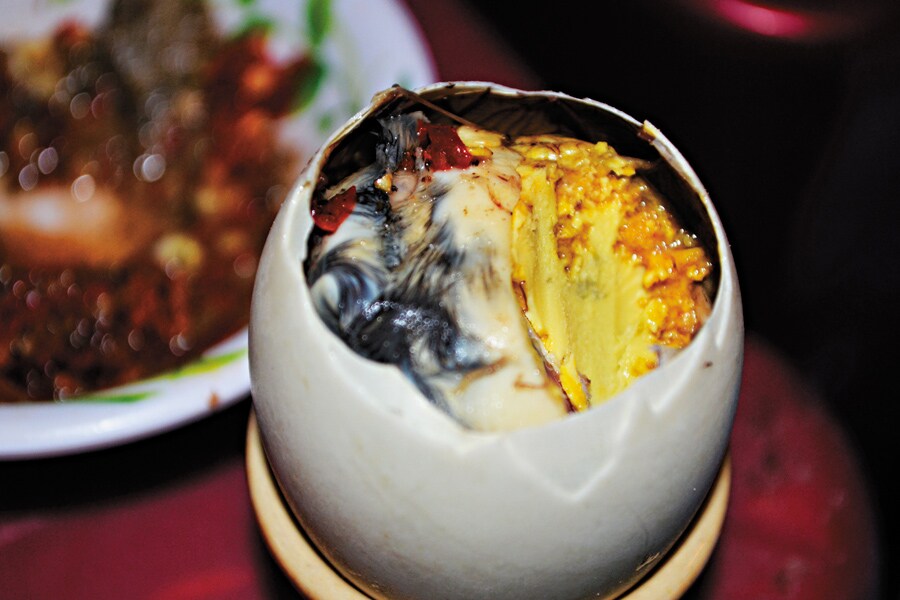The culinary secrets of Vietnam
A culinary trail through the busy streets of Ho Chi Minh City uncovers many layers of Vietnam's bustling city


 The streets in Saigon are full of vendors selling local food, including chicken and ornamental fish
The streets in Saigon are full of vendors selling local food, including chicken and ornamental fish
Image: Justin Mott / Bloomberg via Getty Images
Crossing the road in a Vietnamese city is almost a religious experience. Stepping off the sidewalk and into an unstoppable river of motorbikes is daunting even if you are used to peak-hour traffic anywhere in India. Perhaps life would be easier if I was part of the flow, I thought. I was wrong. On my last evening in Ho Chi Minh City, which I had visited in November last year, I signed up for a food tour that involved riding pillion on a bike. And, within two minutes, I started to regret it.
Ho Chi Minh City—or Saigon, as the locals prefer to call it—has over 7 million bikes for a population of 8 million people. Nothing can prepare you for the chaotic energy of Saigon at rush hour. Bikes zoom along wide boulevards, through narrow alleys and past vendors hawking a variety of goods, including rice, chicken, lanterns and giant springs.
Before we left, my guide and driver for the night, Tien Huynh of XO Tours, made me stow away my bag, camera and phone in the trunk of the scooter. “There’s a lot of bag snatching and pickpockets. It’s much safer to put everything away,” she explained. But it was her next piece of advice—“If you get scared, hold me tight”—that rang in my ears often in the next few hours. As the 5-feet-nothing swerved nonchalantly through bikes and cars on her perky red moped, I clung on to her for dear life and prayed to all gods, old and new.
Vietnamese, like their Indian counterparts, are big believers of jugaad (quick-fix solutions). And such ingenious fixes are ubiquitous on the thing that keeps the city rolling: Bikes. Take the ‘family bikes’ for instance, the ones that have pretty pillows strapped to the handlebar. Explains Tien, “The pillow is for the child. He puts his head on the pillow if he’s sleepy. And if the bike brakes suddenly, the pillow will save the baby from getting hurt. Families teach babies to hold on to the handlebar from an early age.” People can be seen slurping on a steamy bowl of noodles—Vietnam’s de facto national dish—at all times
People can be seen slurping on a steamy bowl of noodles—Vietnam’s de facto national dish—at all times
Image: Getty Images
The plan for the night was to eat and travel like the locals. XO Tours’ food trail is a five-hour affair where 20-something Vietnamese women, dressed in their traditional formal attire, Ao Dai, take tourists to all parts of the city—from District 1 (the main tourist area in the middle of old Saigon) to China Town in District 5 and eventually to District 4, one of the poorest areas in the city. All the while you sample the most authentic Vietnamese food. “You’ll eat food beyond pho (noodle soup), spring roll and banh mi (bread) sandwiches,” promised Tien as we drove to our first stop of the night.
We stopped at Bun Bo Hue Dong Ba, a rickety shack in District 1, which specialised in cuisine from the erstwhile imperial city of Hué. Their most famous offering was Bún bò Hué that translates as beef noodle from Hué—thick rice noodles steeped in a citrusy and spicy broth, laden with thick cuts of pork and beef. “Every bowl of noodle soup is not pho,” said Tai Dang, the tour manager at XO Tours, who was travelling with our motley group. Vietnam’s de facto national dish, he added, has to have velvety fresh rice noodles in a long-simmered broth with hints of roasted ginger and star anise topped with varieties of beef or tripe. In the north of the country, pho is eaten with a simple sprinkling of scallions and chives while in the south, the flavours are amped up with sawtooth herb, basil, mint, sprouts and chili sauce. 
Stir-fried blue crab (Image: Karishma Upadhyay)In the last few decades, Vietnam has shed its image as a war-ravaged country and re-emerged as a gastronomical paradise. Unlike its neighbours, China and Thailand, Vietnam’s cuisine is yet to become a fad in India, but any foodie worth his truffle salt would tell you that it is one of the freshest and most varied in the world. Food is such an integral part of Vietnamese life that there’s a food market around every corner you turn. Walk down any lane at any time of the day and you’ll find a contented soul slurping out of a steaming bowl of noodles or rice.
As we wove through traffic towards our next destination, Tien continued a steady stream of conversation. “Most Vietnamese live in very small homes and don’t have proper kitchens. So almost everyone eats all their meals outside,” she explained. Tien herself lives on her own and ends most days with a quick bite with friends and karaoke. 
Steamed clams (Image: Karishma Upadhyay)We made a quick pit stop at Cholon, Vietnam’s largest Chinatown that dates back to the late 1700s. Spread across Districts 5 and 6, Cholon is almost like a city-within-a-city, with Binh Tay Market as its vibrant beating heart. Binh Tay Market’s central clock tower, butterscotch walls and multi-tiered roofs decked with dragons are among the finest examples of Chinese-French architecture in the city.
Unlike most famous Chinatowns, Cholon hasn’t been Disneyfied as yet. The area that was immortalised in Graham Greene’s novel The Quiet American (1955) continues to be a business and residential neighbourhood for over 600,000 Chinese. Through the rabbit warren, Tien drove past basket-toting shoppers, vendors selling live frogs (one escaped and hopped right past our bike) and delivery bikes laden with chicken and ornamental fish in clear plastic bags. The air was thick with smells of Chinese herbs and slow-burning coils of incense while storefronts were adorned with signs in Chinese and red-and-gold Taoist temples stood close to Catholic churches. 
Grilled frogs (Image: Karishma Upadhyay)We stopped next to an open-fronted medicinal shop that was crammed with cure-alls. As I walked past the huge sacks of roots, herbs, barks and dried mushrooms, I caught a glimpse of a family across the street glued to the TV screen with images that looked distinctly Rajasthani. But before I could ask Tien anything, we were on the move again.
Along the sinuous Saigon River, which flowed through the centre of the city, there were more brightly lit billboards for Toshiba, Coca-Cola and Sony than the typical propaganda hoardings for the Communist Party. But hidden away from the glittering city lights were almost 17,000 shanties that house lakhs of homeless people. “The government plans to relocate them, but it’s proving to be too expensive. These shanties get destroyed almost every year because of the floods and then get re-built again,” said Tien, as she continued giving me a peek into the ‘real’ Vietnam.
Most tourists rarely saw more than District 1’s dizzying blend of glimmering art deco buildings, glass-and-steel towers and sun-dappled gardens. “Locals are not allowed to sit in the gardens so that it looks perfect to tourists,” Tai said with a wry smile. The rest of the city was a jumble of nondescript shops and apartment blocks wedged between iconic ‘tube houses’ (since owners are taxed according to the width of the housefront, most keep it less than 12 feet wide), churches and Chinese temples. And, of course, streets lined with plastic stools from curb-to-building played host to a vibrant food scene to families unwinding after a long day at work. 
Rau Cau Dua, a coconut jelly dessert (Image: Courtesy House of Hao's)Lau De 3Q in District 8 is not a restaurant in the strictest sense of the word. Spread across an area a little larger than a parking lot, there are low tables surrounded by child-size plastic chairs that most foreigners find tough to fold themselves into. On the periphery are stalls with the freshest meat and seafood. Through the haze of barbeque smoke, I saw Vietnamese families out for an informal weeknight meal. Clearly, this was anything but a tourist trap.
On the menu was goat breast marinated with fermented tofu sauce and Coca-Cola, shrimp and beef marinated with chilli and garlic and Tai’s favourite ‘jumping chicken’ aka frogs. “Will you eat it?” he asked cheekily, pointing to a couple of frogs upended, splayed out and smouldering away. With a chilled can of local beer—Bia Saigon—in my hand, I was game for everything.
Across two large tables, each driver/guide sat along with her/his guest cooking the meat on a miniature charcoal grill on the table, peeling the shrimp and filling condiment bowls. While Tien carefully flipped the meat until it was done, Tai walked around cracking jokes. “If you get drunk on too much beer, don’t worry, we’ll tie you to the bike,” he promised a six-plus-foot French techie sitting opposite me.
Ours was an interesting mix of tourists that night—giggling sisters from Australia, an American couple of Vietnamese heritage on their first ever trip to the country, another American couple of Pakistani origin on their honeymoon and an Irish expat who had been living in Saigon for almost a year. “I thought I knew everything about Vietnamese food. Clearly not,” she exclaimed as she bit into a frog. The verdict? “It’s yum and tastes like chicken.” “I told you,” said Tai, who grew up in a small village in the Mekong Delta and had frogs as his staple.
Several beers later, our clothes reeking of smoked meat, we got on to our respective bikes again. As we drove towards District 7, one of the most affluent areas in Saigon, I asked Tien about the TV show I had noticed earlier in Chinatown. “It’s called Cô Dâu 8 Tuoi (Child Bride). It’s from India.” And, that’s when the penny dropped—the show that’s captivated the Vietnamese audience is none other than Balika Vadhu. A quick Google search showed that Child Bride has been Vietnam’s biggest TV show for two years in a row. “I love Child Bride. It’s all about family and love. I really like Anandi, but the old lady (Dadisa played by veteran actor Surekha Sikri) is not very nice,” said Tien, who wants to visit Mumbai to see the set and click a selfie with Avika Gor, the actor who played Anandi till 2010.  Balut — fertilised duck egg that’s boiled and eaten out of its shell
Balut — fertilised duck egg that’s boiled and eaten out of its shell
Image: Karishma Upadhyay
As Tien got me up to speed with the politics of Child Bride, we entered District 7. It looked nothing like the rest of Saigon—wide roads, with barely any traffic no overhead wires that Vietnam is famous for and trendy eateries and boutiques. “Welcome to Singapore,” Tai joked as we stopped off the main boulevard. “Real estate is a major investment for the rich Vietnamese,” he explained, pointing at sparely lit high-rise towers around the main boulevard.
Along with District 2, this modern residential suburb is a big favourite with Saigon’s burgeoning expat community. “Almost all these condos are empty because people have just bought and left them. They are never rented out. While most of Saigon is crammed into tiny homes, the rich have so many beautiful houses lying empty,” he said.
The last stop of the night was in Vinh Khanh in District 4. “This is one of the poorest areas in the city but has the freshest seafood,” Tien said as we sat on stools so low that they almost touched the ground. We were first served plates of blue crab legs stir-fried with chilli and peppers, steamed clams steeped in lemongrass, tamarind, chilli and basil and grilled scallops with peanuts, green onions and fish sauce. And then, as if to keep their best for the last, Tien asked with an impish smile, “Are you ready for the biggest delicacy of the night?” From the kitchen, out came balut.
A favourite snack in Vietnam, Philippines and Cambodia, balut is fertilised duck egg that’s boiled and eaten out of its shell. While it is high on the must-try list of every self-respecting gourmand, it also has many—including participants on reality shows like Fear Factor and Hell’s Kitchen—squirming. Instead of garnishing the egg with salt, pepper, lemon juice and mint leaves, I decided to eat it on its own. I was happy to have ticked it off my bucket list, but balut won’t be my first choice for a beer snack. While there were some crunchy bits, and a rich duck broth, the largely inedible rubbery egg, which tasted like a chicken egg on steroids, wasn’t really my thing. More than that, I enjoyed Rau Cau Dua, a coconut jelly dessert that capped off this night of many meals.
As Tien dropped me back to my hotel at the end of the night, I spotted a street chef whipping up bowls of chewy tapioca noodles steeped in thick coconut sauce, pickled vegetable and pork meatball. I sat down for one last bowl of Vietnamese goodness, inches away from zipping bikes. Saigon is a magical place that makes you forget your fears.
First Published: Nov 19, 2016, 06:12
Subscribe Now(This story appears in the Dec 31, 2010 issue of Forbes India. To visit our Archives, Click here.)